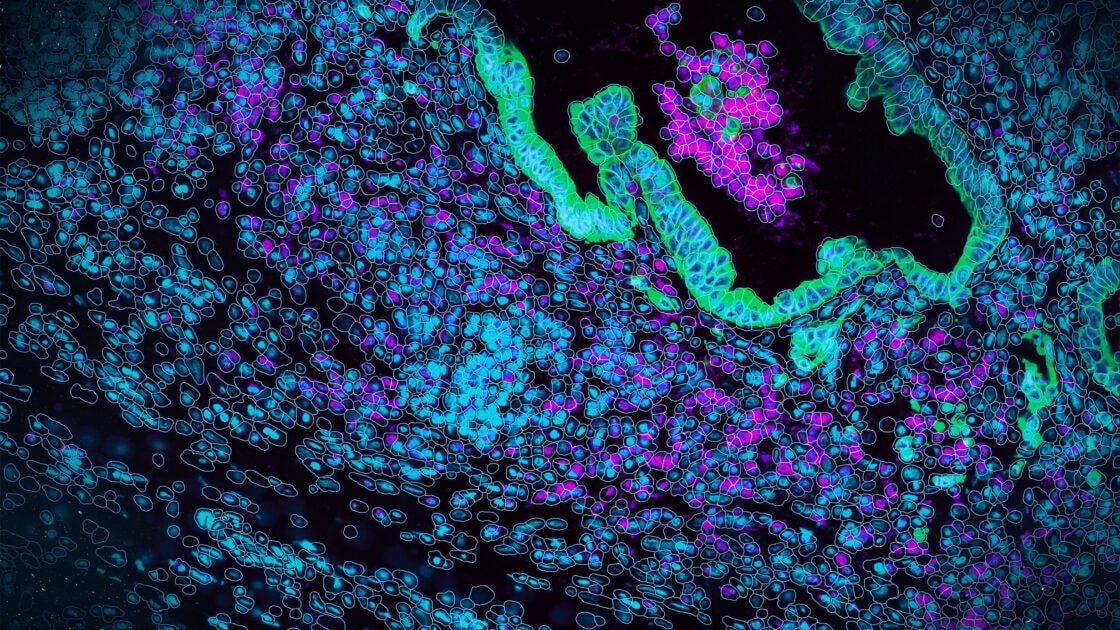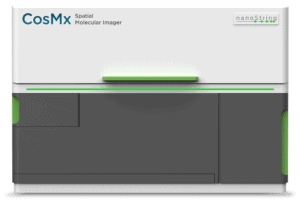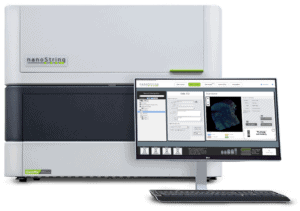
What are NanoString platforms used for?
A pioneer in the field of spatial biology, NanoString Technologies has developed automated workflow platforms enabling researchers to visualize and quantify gene and protein expression in tissue sections down to single-cell and subcellular resolutions.
NanoString uses oligonucleotide barcodes tagged with antibodies or in situ hybridization (ISH) probes to quantify RNA or protein expression in two- or three-dimensional space. NanoString’s spatial biology solutions include the GeoMx® Digital Spatial Profiler (DSP), CosMx™ Spatial Molecular Imager (SMI), nCounter® Analysis System, and an integrated analysis tool: the AtoMx™ Spatial Informatics Platform (SIP).
The GeoMx Digital Spatial Profiler
Among the first spatial multiomic technologies introduced to the market, the GeoMx DSP is a fully automated, high throughput, and multiplex spatial profiler that combines the power of whole tissue imaging with RNA and protein expression for doing spatial transcriptomics and proteomics on various sample types, including formalin fixed, paraffin-embedded (FFPE) tissue sections. The GeoMx DSP utilizes standard immunofluorescence techniques with oligonucleotide barcoding technology to spatially profile tens to thousands of mRNA transcripts, or 150+ protein analytes, separately or simultaneously in a short amount of time.
The barcoding technology consists of antibodies or RNA probes that are tagged with a photocleavable oligonucleotide. These tagged oligonucleotides are released upon exposure to UV light projected on a user-defined region of interest (ROI) of the tissue. These tags are then collected and quantitated with optical barcodes using the nCounter platform or via sequencing on an Illumina next-generation sequencer (NGS).
One of the major advantages of the GeoMx DSP is that it allows for flexible and customizable ROI selection for profiling. Guided by the immunofluorescent staining of the tissue, the GeoMx DSP software allows for the selection of ROIs on the tissue that trace out the boundaries of anatomical or biological structures, groups of specific cells, or contour lines at a given distance to specific tissue structures.
The CosMx Spatial Molecular Imager
The CosMx™ SMI and decoder probes are not offered and/or delivered to the Federal Republic of Germany for use in the Federal Republic of Germany for the detection of cellular RNA, messenger RNA, microRNA, ribosomal RNA and any combinations thereof in a method used in fluorescence in situ hybridization for detecting a plurality of analytes in a sample without the consent of the President and Fellows of Harvard College (Harvard Corporation) as owner of the German part of EP 2 794 928 B1. The use for the detection of cellular RNA, messenger RNA, microRNA, ribosomal RNA and any combinations thereof is prohibited without the consent of the President and Fellows of Harvard College (Harvard Corporation).

The recently launched CosMx SMI expands on the technology of GeoMX DSP. An integrated sample-to-result in situ single-cell spatial multiomics platform, it is a highly sensitive imager capable of profiling both RNA transcripts and protein levels at single-cell or subcellular resolution. CosMx SMI is capable of rapid quantification and visualization of up to 1000 RNAs or 64 proteins within morphologically intact FFPE tissue or fresh frozen tissue sections.
The CosMx platform uses a combination of sensitive cyclic ISH probes and an ultra-high-resolution imaging readout instrument. The workflow of the CosMx SMI is tunable for either low-plex and high-throughput or high-plex and lower-throughput analysis. CosMx complements single-cell RNA-seq data and provides insights for cell atlasing, tissue phenotyping, cell-cell interaction analysis, understanding cellular processes, and biomarker discovery.
The nCounter Analysis System

The nCounter Analysis System is an automated nucleic acid hybridization-based technology capable of quantifying the expression of hundreds of RNA transcripts, miRNAs, or copy number variations with high sensitivity and precision. The nCounter system works well with a variety of starting materials from fresh or FFPE tissue sections to cell lysates or biological fluid samples.
The nCounter technology uses color-coded oligonucleotide barcodes to detect and quantify up to 800 targets at a time from 12 samples in a single assay. Each barcode is made up of six differently colored fluorophores, enabling highly multiplexed, single molecule counting. Further, the assay does not require reverse transcription, library preparation, or amplification that may introduce bias to the results. The workflow of the nCounter system is simple and efficient consisting of hybridization, post-hybridization processing, digital data acquisition, and normalization. NanoString has developed many off-the-shelf gene expression panels that are available for a wide variety of biological pathways and research areas.
The AtoMx Spatial Informatics Platform

NanoString’s AtoMx SIP is a cloud-based informatics tool that provides an integrated platform to work with spatial biology data from multiple instrument systems. The AtoMx SIP provides a streamlined workflow to manage, analyze and share data from GeoMX DSP and CosMx SMI experiments, thereby decreasing analysis time.
Further, the cloud computing power can easily be used for the creation and execution of custom analysis pipelines for researchers. The AtoMx SIP also enables secure data sharing for collaboration across laboratories and institutions. This is particularly beneficial for spatial multiomics data analysis based on artificial intelligence.


